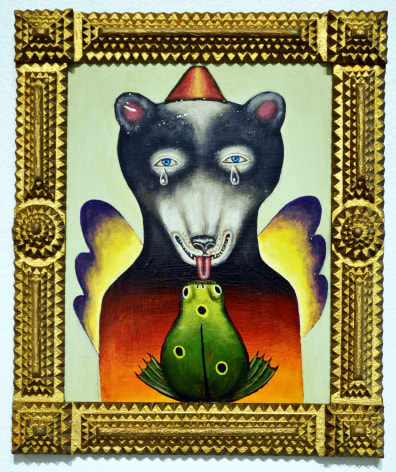
Prince
2022
Acrylic on panel with antique tramp art frame
13.5” x 11.5”
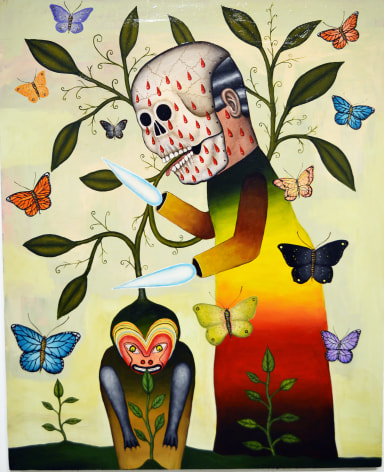
Lifeline
2022
Acrylic on canvas
60” x 48”

Forked Tongue
2022
Acrylic on panel with antique tramp art frame
13” x 10”
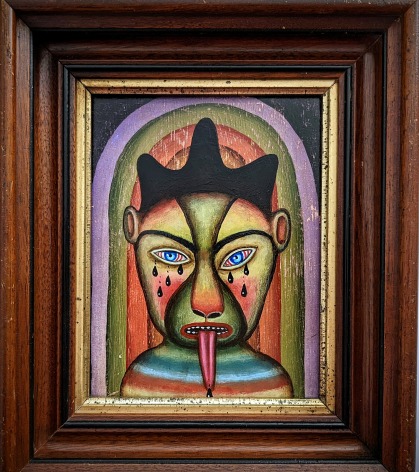
Time Tunnel
2022
Acrylic on panel with antique frame
11.5” x 9.5”
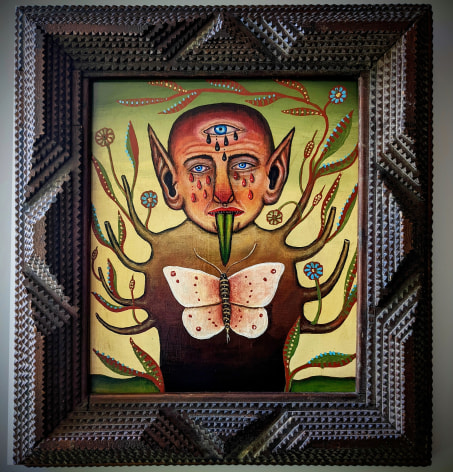
Midsummer
2022
Acrylic on panel with antique tramp art frame
17” x 15”
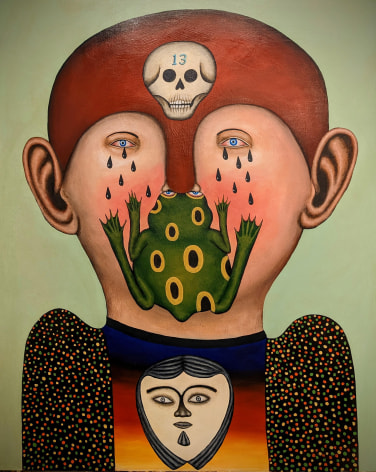
Talismans
2022
Acrylic on wood
60” x 48”
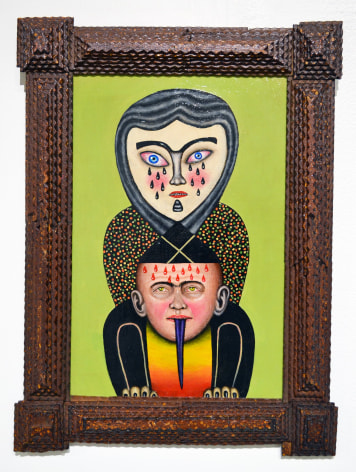
Soldier
2023
Acrylic on panel with antique tramp art frame
21” x 16”
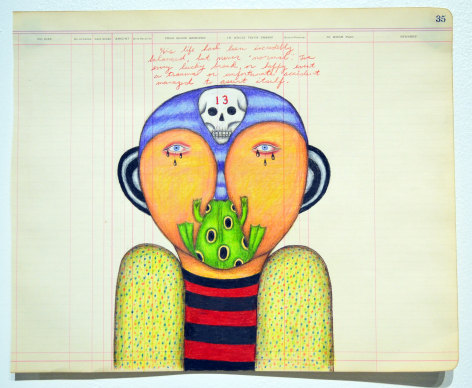
13
2022
Colored pencil on antique ledger paper
14” x 17”

Can’t
2022
Colored pencil on paper
9” x 12”
SOLD
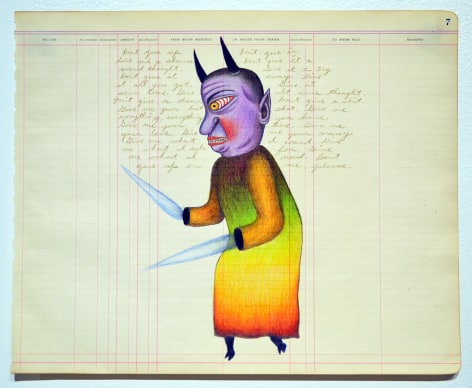
Don’t Give Up
2022
Colored pencil on antique ledger paper
14” x 17”
Doorway of Sleeplessness
2022,
Colored pencil on antique ledger paper
14” x 17”
Jack
2022
Colored pencil on antique ledger paper
14” x 17”
No Pity
2022,
Colored pencil on antique ledger paper
14” x 17”
Now and Then
2022
Colored pencil on antique ledger paper
14” x 17”
SOLD
Pissant
2022
Colored pencil on antique ledger paper
14” x 17”
Presence
2022
Colored pencil on antique ledger paper
14” x 17”
Remembering
2022
Colored pencil on a vintage file folder
12” x 9”
SOLD
Secrets
2022
Colored pencil on paper
9” x 12”
SOLD
The Killer Inside
2022
Colored pencil on a vintage file folder
9” x 12”
The Longest Dream
2022
colored pencil on antique ledger paper
14” x 17”
Waiting
2022
Colored pencil on antique ledger paper
14” x 17”
Last Chance
2015
Acrylic on panel
20 x 12 Inches
FS 325
Root Man
2019
Acrylic on panel
28 x 20 inches
THE DREAMS WHERE I DIE
2015
Acrylic on panel
48 x 36 inches
FS 301
The Birth of Reason
2015
Acrylic on wood
24 x 18 inches
FS 305
The Curse of Impatience
2015
Acrylic on panel
20 x 14 inches, panel
26 x 20 inches framed
FS 306
Going the Distance
2015
Acrylic on wood
24 x 18 inches
FS 304
SOLD
A Lingering Doubt
2013
Acrylic on wood
48 x 36 inches
FS 295
Orphans Home
2014
Acrylic on panel with antique frame
16.5 x 14.5 inches including frame
FS 297
FRED STONEHOUSE
Emblems
Exhibition dates: March 10 – April 29, 2023
Recently, in a conversation with an artist friend, I tried to describe the source of the new figures in my current work. I asked: “Do you know how, in dreams, you sometimes sense a figure or presence that is lurking just out of sight, maybe somewhere just behind you, down very low or looming above?” She replied: “No. My dreams aren’t like that.” I laughed at the bluntness of her response, but it made me think about how we each have our own sense of powerful presences in life, whether they occur in dreams or in our waking reality, and how they can serve as emblems of mystery or perhaps even meaning in our understanding of personal symbols. My work has always mined dreams as a source for imagery and narrative but in this new work, the narrative has taken a backseat to that emblematic presence in the form of mysterious personal totems, or spirit figures, both animal and human. To be sure, the narrative is still present in the work, especially with the text-heavy drawings included in the show, but the paintings are solemnly mute, relying on that sense of symbolic power that an “Emblem” can contain. These totemic figures have allowed me to explore color, symmetry, and pattern in a way that is new for me and quite exciting from the perspective of painting and drawing. The tension between ornamental flatness and naturalistic volume in these works has pushed the practice into new visual terrain that feels like the opening of a novel and an unfamiliar door in my creative process. “Emblems” represents my first foray into the space that exists beyond that door.
___________________________________________________________________________________________
FRED STONEHOUSE
Storyland
Hybrids, Hoaxes, and the Hodag
Images of the Fantastic from the Wisconsin Storytelling Traditions
Exhibition dates: November 6, - December 23, 2015
From Native American tradition and the tall tales of early lumber camps, to the transplanted folklore of our many immigrants, Wisconsin has registered a complex tradition of mythic storytelling. The tradition of tall tales in Wisconsin arose, in part, from the practice of storytelling around campfires and in the bunkhouses of logging camps. At the end of a long and physically strenuous day chopping down trees, the lumberjacks would gather to swap stories before turning in for the night. It was common in the bunkhouses of Wisconsin for there to be a bench, usually constructed of split logs, extending along the front of the bunks from which a storyteller would entertain the loggers. This bench was known as the “Deacon’s Seat”. One could only hold the “Deacon’s Seat” as long as the audience was engaged. Holding the seat for an extended period was the storyteller’s mark of pride. It followed that the more finely crafted and the more fantastical the tale, the longer the storyteller held the attention of his audience. These were hard men engaged in hard and dangerous work; men not easily taken in by a boring story. The exaggeration of these stories had to be tempered with elements of humor, adventure, and an understanding of the human condition in order for them to be of lasting interest.
The storyteller’s impulse to exaggerate and invent for creative effect is one that drives Fred Stonehouse’s narrative pursuits. These imaginative fabrications have held their appeal for many generations and they would be interesting and worth researching for that reason alone, but Stonehouse pursues a deeper understanding of the power that these fabulous stories contain beneath the quaint or historical attraction that is apparent on the surface. The practice of inventing hybrid creatures likely has its roots in older myths, but the impulse to create a character that embodies the traits of its constituent parts speaks to an ongoing desire; one of mastery over nature and the fearsome creatures that populate the wild of our collective imagination.
In the introduction to their book Weird Wisconsin, Linda Godfrey and Richard Hendricks state: “In 1634, Jean Nicolet became the first European to land in Wisconsin. Dressed in a flowing Chinese robe embroidered with flowers and birds (alas, he thought he had reached China!), he came ashore near what is now Green Bay firing two raised pistols in an ostentatious display of his majesty. More Europeans followed, importing their wild mélange of folkways and ancestral spirits. All the millions of souls that have since crisscrossed the Badger State have left their history imprinted on the land, but you won’t find most of it written about in official textbooks or inscribed on tourism markers or handed out in glossy flyers by chambers of commerce.”
One of the most popular and enduring creatures from Wisconsin folklore is the Hodag of Rhinelander. While the exact origins of the story are not clear, the earliest recorded reference was planted in a newspaper in 1893 by the well- known local prankster Eugene Shepard. The paper reported that the Hodag had “the head of a frog, the grinning face of a giant elephant, thick short legs set off by huge claws, the back of a dinosaur, and a long tail with spears on the end”. A group of locals was rounded up to capture the ferocious beast and reported that they needed to use dynamite to finally subdue it. The Hodag eventually became extinct when its primary food source, pure white bulldogs, became scarce in the area.
A popular photo postcard of the Hodag can still be found in Wisconsin antique shops. The image represents the best efforts of a local taxidermist to create a convincing monster. It was reportedly constructed of body parts from a bear, a dog, a mountain lion and whatever extra bits he had lying about. Shepard displayed the beast at county fairs for a number of years until it was destroyed in a fire.
Throughout Wisconsin, compelling local legends such as the Goat Man of Hogsback Road in Hubertus, the Beast of Bray Road near Elkhorn, the Mauston Birdman and the various lake monster legends serve loosely as models for the characters in Stonehouse’s new paintings and drawings, re-contextualizing these traditional legends into his own personal narrative construct.
The characters in Stonehouse’s work have typically been drawn from this pool of familial and cultural lore and appear to be descended from long ages of inbred hybrids, whose former mythic status is lost to history. The narratives read like fables whose players have departed from the story line. They expose themselves as vulnerable operators, hanging on by just a thread, scraping and foraging to exist in a world that no longer recognizes their kind.
Fred Stonehouse sees their fragility and deformity as a metaphoric equivalent to the human condition. They hobble along in their ongoing struggle to survive, finding small joys along the way, retaining hope that things won’t stray too far off the path of the manageable. Memories, dreams, fragments of text, anecdotal bits and pieces from everyday life – these are some of the elements that comprise my conceptual vocabulary. Stonehouse’s paintings, while clearly describing some alternate world, full of miraculous and disturbing images, have the familiarity of our own past and the memory of myth and folklore residing there.
Locating an existing myth or folkloric character outside of its original context separates it from its didactic purpose and/or its function as entertainment. The artist (Stonehouse) is interested in the capacity of these old stories to raise questions and resonate with a contemporary audience. While a character may be a cross between a bear and a human, she or he struggles with the same emotions, the same quest for self-knowledge and fulfillment with which we all struggle.


















